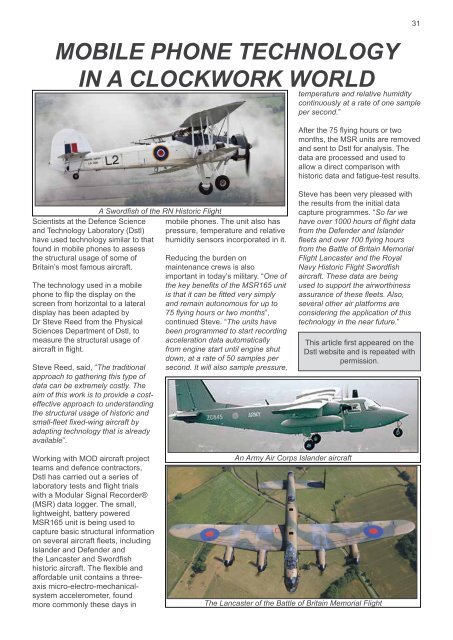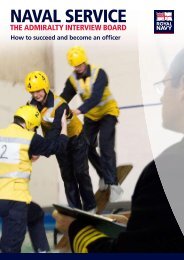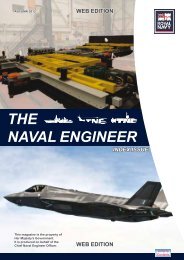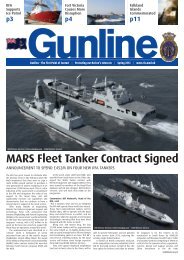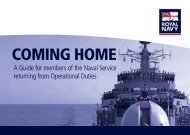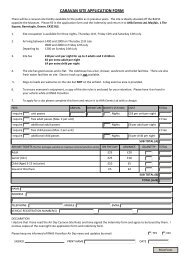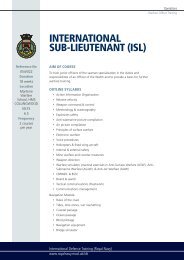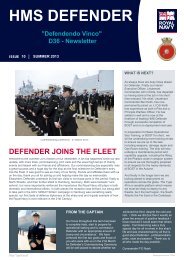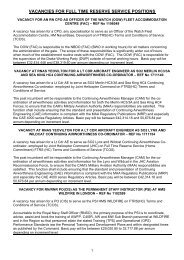THE NAVAL ENGINEER
THE NAVAL ENGINEER
THE NAVAL ENGINEER
Create successful ePaper yourself
Turn your PDF publications into a flip-book with our unique Google optimized e-Paper software.
Mobile Phone Technology<br />
in a Clockwork World<br />
31<br />
temperature and relative humidity<br />
continuously at a rate of one sample<br />
per second.”<br />
After the 75 flying hours or two<br />
months, the MSR units are removed<br />
and sent to Dstl for analysis. The<br />
data are processed and used to<br />
allow a direct comparison with<br />
historic data and fatigue-test results.<br />
Scientists at the Defence Science<br />
and Technology Laboratory (Dstl)<br />
have used technology similar to that<br />
found in mobile phones to assess<br />
the structural usage of some of<br />
Britain’s most famous aircraft.<br />
The technology used in a mobile<br />
phone to flip the display on the<br />
screen from horizontal to a lateral<br />
display has been adapted by<br />
Dr Steve Reed from the Physical<br />
Sciences Department of Dstl, to<br />
measure the structural usage of<br />
aircraft in flight.<br />
Steve Reed, said, “The traditional<br />
approach to gathering this type of<br />
data can be extremely costly. The<br />
aim of this work is to provide a costeffective<br />
approach to understanding<br />
the structural usage of historic and<br />
small-fleet fixed-wing aircraft by<br />
adapting technology that is already<br />
available”.<br />
A Swordfish of the RN Historic Flight<br />
mobile phones. The unit also has<br />
pressure, temperature and relative<br />
humidity sensors incorporated in it.<br />
Reducing the burden on<br />
maintenance crews is also<br />
important in today’s military. “One of<br />
the key benefits of the MSR165 unit<br />
is that it can be fitted very simply<br />
and remain autonomous for up to<br />
75 flying hours or two months”,<br />
continued Steve. “The units have<br />
been programmed to start recording<br />
acceleration data automatically<br />
from engine start until engine shut<br />
down, at a rate of 50 samples per<br />
second. It will also sample pressure,<br />
Steve has been very pleased with<br />
the results from the initial data<br />
capture programmes. “So far we<br />
have over 1000 hours of flight data<br />
from the Defender and Islander<br />
fleets and over 100 flying hours<br />
from the Battle of Britain Memorial<br />
Flight Lancaster and the Royal<br />
Navy Historic Flight Swordfish<br />
aircraft. These data are being<br />
used to support the airworthiness<br />
assurance of these fleets. Also,<br />
several other air platforms are<br />
considering the application of this<br />
technology in the near future.”<br />
This article first appeared on the<br />
Dstl website and is repeated with<br />
permission.<br />
Working with MOD aircraft project<br />
teams and defence contractors,<br />
Dstl has carried out a series of<br />
laboratory tests and flight trials<br />
with a Modular Signal Recorder®<br />
(MSR) data logger. The small,<br />
lightweight, battery powered<br />
MSR165 unit is being used to<br />
capture basic structural information<br />
on several aircraft fleets, including<br />
Islander and Defender and<br />
the Lancaster and Swordfish<br />
historic aircraft. The flexible and<br />
affordable unit contains a threeaxis<br />
micro-electro-mechanicalsystem<br />
accelerometer, found<br />
more commonly these days in<br />
An Army Air Corps Islander aircraft<br />
The Lancaster of the Battle of Britain Memorial Flight


